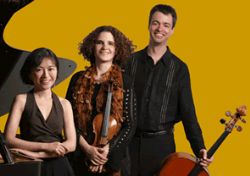|
Choral and Vocal
CANTIAMO SONOMA'S LUSCIOUS A CAPELLA SINGING IN SEASON ENDING CONCERT
by Pamela Hicks Gailey
Sunday, June 8, 2025
Symphony
SRS SEASON ENDS WITH RESOUNDING TA-TA-TA-BANG
by Terry McNeill
Sunday, June 1, 2025
Symphony
YOUTHFUL VIRTUOSITY ON DISPLAY AT USO'S MAY CONCERTS
by Peter Lert
Saturday, May 17, 2025
Symphony
MYSTICAL PLANETS AND LIVELY GERSHWIN ORTIZ AT FINAL SRS CONCERT
by Peter Lert
Sunday, May 4, 2025
Symphony
VSO'S CONCERT MUSIC OF TIME, MUSIC OF PLACE
by Peter Lert
Sunday, April 27, 2025
VOCAL ELEGANCE AND FIRE AT THE 222'S RECITAL APRIL 26
by Pamela Hicks Gailey
Saturday, April 26, 2025
CANTIAMO SONOMA SINGS AN INSPIRED GOOD FRIDAY MOZART REQUIEM CONCERT
by Pamela Hicks Gailey
Friday, April 18, 2025
DRAMATIC SHOSTAKOVICH SYMPHONY CLOSES PHILHARMONIC'S 25TH SEASON
by Terry McNeill
Sunday, April 13, 2025
LARGE COLLEGE OF MARIN AUDIENCE GREETS STOPHER ARTISTRY
by Terry McNeill
Saturday, April 5, 2025
Chamber
FRISSON DELIVERS SHIVERS OF DELIGHT
by Abby Wasserman
Sunday, March 30, 2025
|
 |
 Amelia Piano Trio |
POISED ON THE EDGE OF GREATNESS
by Steve Osborn
Friday, April 16, 2010
For its program at Santa Rosa’s Newman Auditorium on April 16, the Amelia Trio opted for three unknown piano trios by known composers: Debussy, Bernstein and Chopin. All three trios are the works of teenagers, composed around the ages of 18 (Debussy), 19 (Bernstein) and 18 (Chopin). Although they all qualify as juvenilia, each trio already contains many elements of the composer’s characteristic style.
Those characteristics were evident during the opening bars of the Debussy, which were suffused with his signature impressionist style. Lush and sensuous tones predominated, heightened by the Amelia’s utterly relaxed playing. The musicians were clearly well rehearsed, and the string players rarely consulted their scores. Instead of burying their heads in notes, they looked at each other meaningfully while filling the room with gorgeous sound. Glissandos were the order of the day. Violinist Anthea Kreston was remarkably fluid and assured, and her cellist husband Jason Duckles matched her with a beautiful tone that carried throughout the acoustically resonant space.
Complementing this elegant couple was the diminutive pianist Rieko Aizawa, who played with the lid fully open, the better to control her dynamics. She is a consummate chamber musician, never letting her instrument overpower the strings, but rising to the soloistic occasion when circumstances demand.
All three played the Debussy to the hilt, moving from the expansiveness of the first movement, to the well articulated pizzicatos of the second, to the enchanting cello solo in the third, and finally to the cascading rhythms and forward propulsion of the last. It was a great performance, and the music was clearly like Debussy, but it wasn’t one of the later masterpieces that make his work so distinctive. Instead of real Debussy, it was a debut.
The situation was much the same with the Bernstein trio, which he composed while an undergraduate at Harvard. The sparse beginning led to frantic string work over a steady piano. Here Aizawa’s playing stood out, her lines articulated with an assured attack. The piano is, after all, a percussion instrument, and she brought those qualities to the fore while acting as a foil to the fluid string work.
The Bernstein unfolded as one might expect for a work written in 1937, when the jazzy rhythms of New York City were still relatively new. There was lots of pizzicato, lots of starts and stops, lots of playfulness. Again, it wasn’t a masterpiece, but it contained many of the familiar styles that bloomed in West Side Story and On the Town.
As for Chopin, the rarity of the trio performance was made extra rare by Kreston’s decision to play the violin part on a viola. In a witty introduction, she explained how Chopin himself had expressed the view that he should have written the violin part for viola, given that it “would accord better with the cello.” Indeed, most of the action occurs on the D and A strings, a domain that the viola shares with the violin. Based on this evidence, Kreston transcribed the violin part to the viola, retaining almost all the original notes, with only occasional forays downward.
Whatever the historical authenticity, Kreston demonstrated that she is a consummate chin player, equally at home on the violin, viola, or any other instrument that might fit under her chin. Her viola did indeed accord beautifully with the cello, particularly in the second movement, which features an extended duet between the two instruments.
As is inevitable with Chopin, however, the piano eventually came to the fore. After three movements of relatively balanced music, the fourth opened with a big piano solo and went on from there. It’s the only movement that really sounds like Chopin, with evocative Polish dance themes emerging from a filigree of notes. Both Kreston and Duckles stood aside as Aizawa played Chopin to the max. Like everything else on the program, it was a great performance, offering a lucid view of the composer’s early strivings toward a mature style.
That view summed up the entire performance. Three composers poised on the edge of greatness, played by a trio that is just beginning to hit its prime.
|
